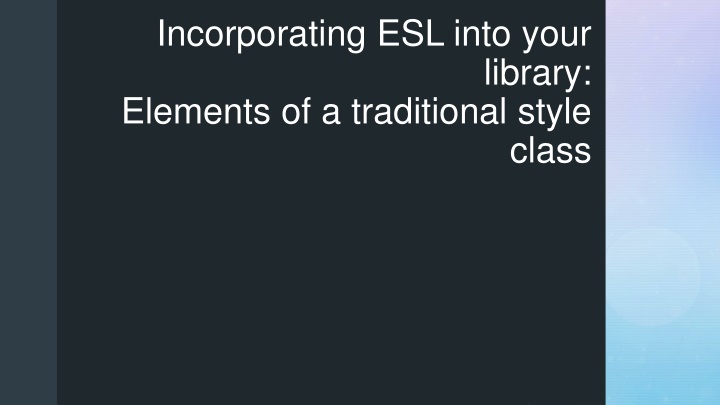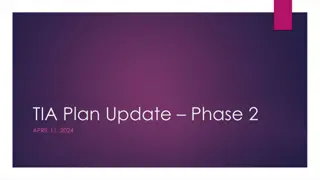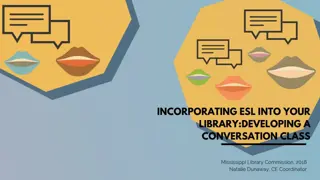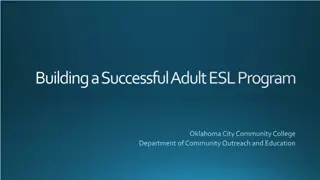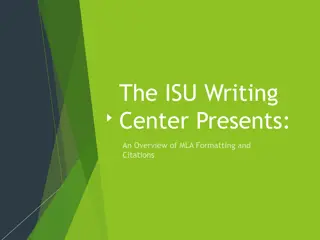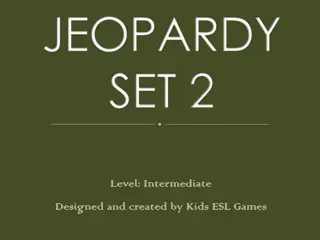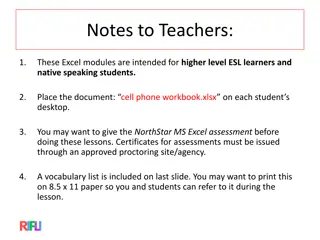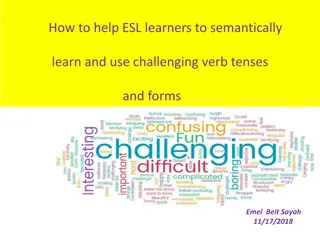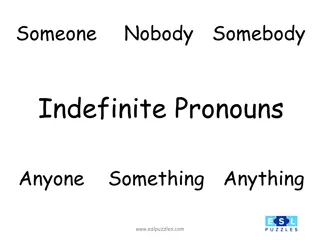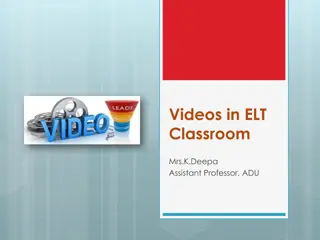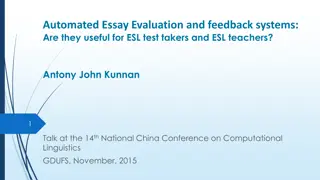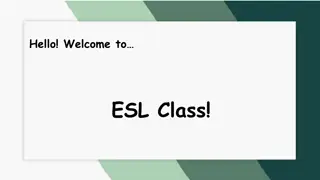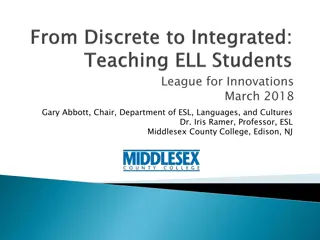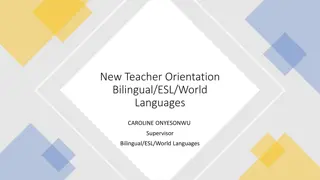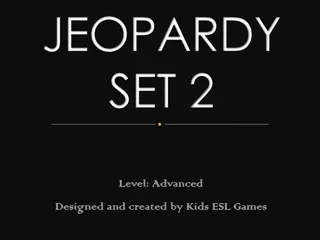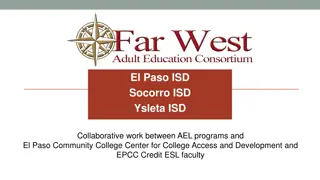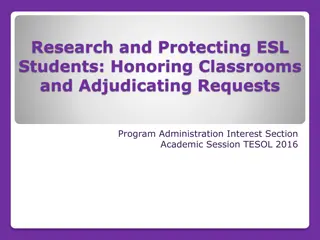Incorporating ESL: Traditional Style Class Essentials
Explore the essential elements of a traditional style ESL class, from curriculum planning to assessment strategies. Discover tips on class profile, lesson planning, and effective teaching techniques. Get insights on structuring sample lessons and engaging warm-up activities. Enhance your ESL programs by incorporating volunteer teachers and catering to community needs.
Download Presentation

Please find below an Image/Link to download the presentation.
The content on the website is provided AS IS for your information and personal use only. It may not be sold, licensed, or shared on other websites without obtaining consent from the author.If you encounter any issues during the download, it is possible that the publisher has removed the file from their server.
You are allowed to download the files provided on this website for personal or commercial use, subject to the condition that they are used lawfully. All files are the property of their respective owners.
The content on the website is provided AS IS for your information and personal use only. It may not be sold, licensed, or shared on other websites without obtaining consent from the author.
E N D
Presentation Transcript
Incorporating ESL into your library: Elements of a traditional style class
Elements of a traditional style class Will include a curriculum or teaching plan Teacher led vs. student led Demonstration Recitation Translation Assessment Research your community- see if you can find a volunteer teacher
Things to keep in mind Class profile Who is this class for? If this is a class of beginners, you ll have to teach the basic mechanics of the language- phonetics, alphabet and vocabulary How many people? The number of people will change your dynamic Age range?
Things to keep in mind Lesson planning How often are you looking to have the class? What is the purpose of the class? Do you have any particular topics/subjects your community members specifically need? What skills do you want to develop? Keep in mind preparation
Things to keep in mind Assessment You can incorporate any sort of task that requires the demonstration of acquired skills Formal traditional assessment- think pen and paper test Think a little more authentic- tasks that demonstrate ability Keep in mind stress levels
Sample Lesson Structure What my classes looked like: 1. Greeting/ Warm up Hello! How are you? (5 minutes) 2. Review of previously learned material + short activity (10 minutes) 3. Introduce new material + teacher led activity (25 minutes) 4. Student led activity (15 minutes) 5. Goodbye/Cool down (5)
Getting started Some tips to keep in mind: These are things you can do, but don t necessarily have to. Giving an initial assessment-checking what is already known Run through the basics-cover all the bases Speak clearly and consistently Be careful not to ramble-keep in mind colloquialisms Keep in mind body language Keep in mind cultural differences Unless someone specifically indicates that they d like you to speak up, talking louder doesn t help people understand you
Getting started Warming Up Exercise that gets people interacting Small game or greeting Keep your warm up consistent with each class Ex: Asking how are you- reporting Play a game- Mix up sentences Odd one out Two truths and a lie *Remember that you can demonstrate Review/Checking In Check for questions. Briefly review previous material to check comprehension. Can spend more time on review if needed.
Getting started Lesson Introduce new material Consist of demonstration and some recitation-teacher focused Incorporate a teacher-led activity Activity and Cool Down Student led activity using newly learned material, as well as previously learned material-want to really encourage treating lessons as building blocks. Facilitate and scaffold, but let students work together and try and self correct
Working With Adults You can have fun! Adults get bored, too! But be wary of being overtly silly Be careful not to embarrass- Keep in mind sarcasm (it does not translate) Keep in mind their motivations for learning Don t be afraid to recommend picture books to adults: Have picture books available for adults learning English (you can even bring them to class) they are a great way to build basic vocabulary and sentence structure Examples: Frog and Toad by Arnold Lobel Aesop s Fables- perhaps with pictures The House on Mango Street by Sandra Cisneros The Outsiders by S.E. Hinton Charlottes Web by E.B. White
Working With Teens and Children May be improving language skill on a more general level Keep in mind school- partnership Have a good number of engaging activities- Think TPR (Total Physical Response) For young children, of course games, music, sing along, etc work well. Think storytime-style content.
A few resources for ESL for children Songs with numbers, colors, etc. that is multi sensory For young ELL s: Simple songs: Five little ducks: https://www.youtube.com/watch?v=pZw9veQ76fo Open, Shut them, https://www.youtube.com/watch?v=DzA1VQL1oME Are you hungry? https://www.youtube.com/watch?v=ykTR0uFGwE0&list=PLdkj6XH 8GYPQhGbx6xmlMyv-vRRqf-oHc&index=3
A few resources for ESL for children Books for early learners: The Lion and the Mouse by Jerry Pinkney Aesop s Fables; Wordless book Goodnight moon by Margaret Wise Brown A classic, this has simple sentences, repetition, and is great for learning new words The Very Hungry Caterpillar by Eric Carle Teaches numbers and food Strega Nona by Tomie dePaola A little more advanced, complex sentences But great for illustration, and connecting concepts
A few resources for ESL for children My Clothes/Mi Ropa by Rebecca Emberly Teaches basic clothing Mouse Paint/Pintura de rat n by Ellen Stoll Walsh Teaches children about creating colors
Online resources: Online resources: http://www.englishmedialab.com/ A huge resources with tons of interactive and online quizzes and exercises *Some English is British English pronunciation https://www.tefl.net/ref/ A number of free board games, lesson plans, and templates https://www.teachingenglish.org.uk/teaching-kids/resources Part of the BBC, has resources for teaching kids and free lesson plans https://www.education.com/ Initial account is free, but premium access does cost money
Let s get a little technical As I mentioned, scout your community for a teacher (if you don t have one at your library) High schools? Senior projects Consider the vast technicalities that go with solidifying basic knowledge of English Phonetics Punctuation Writing practice You re going to have to be strategic and purposeful with your teaching
Let s get a little technical For phonics: https://www.fluentu.com/blog/educator-english/esl-pronunciation-activities/ http://www.abcfastphonics.com/index.html For writing, reading, grammar and listening: https://eslgold.com/ This is a large resource with interactive videos and exercises for all language levels http://www.elllo.org/ This has tons of interactive activities with conversations, quizzes, downloadable worksheets, and printable conversations. https://www.thoughtco.com/esl-writing-skills-4133091 This is a more advanced resource, but provides examples and advice on developing professional writing skills.
Natalie Dunaway, Continuing Education Coordinator Mississippi Library Commission 601-432-4057 or ndunaway@mlc.lib.ms.us
